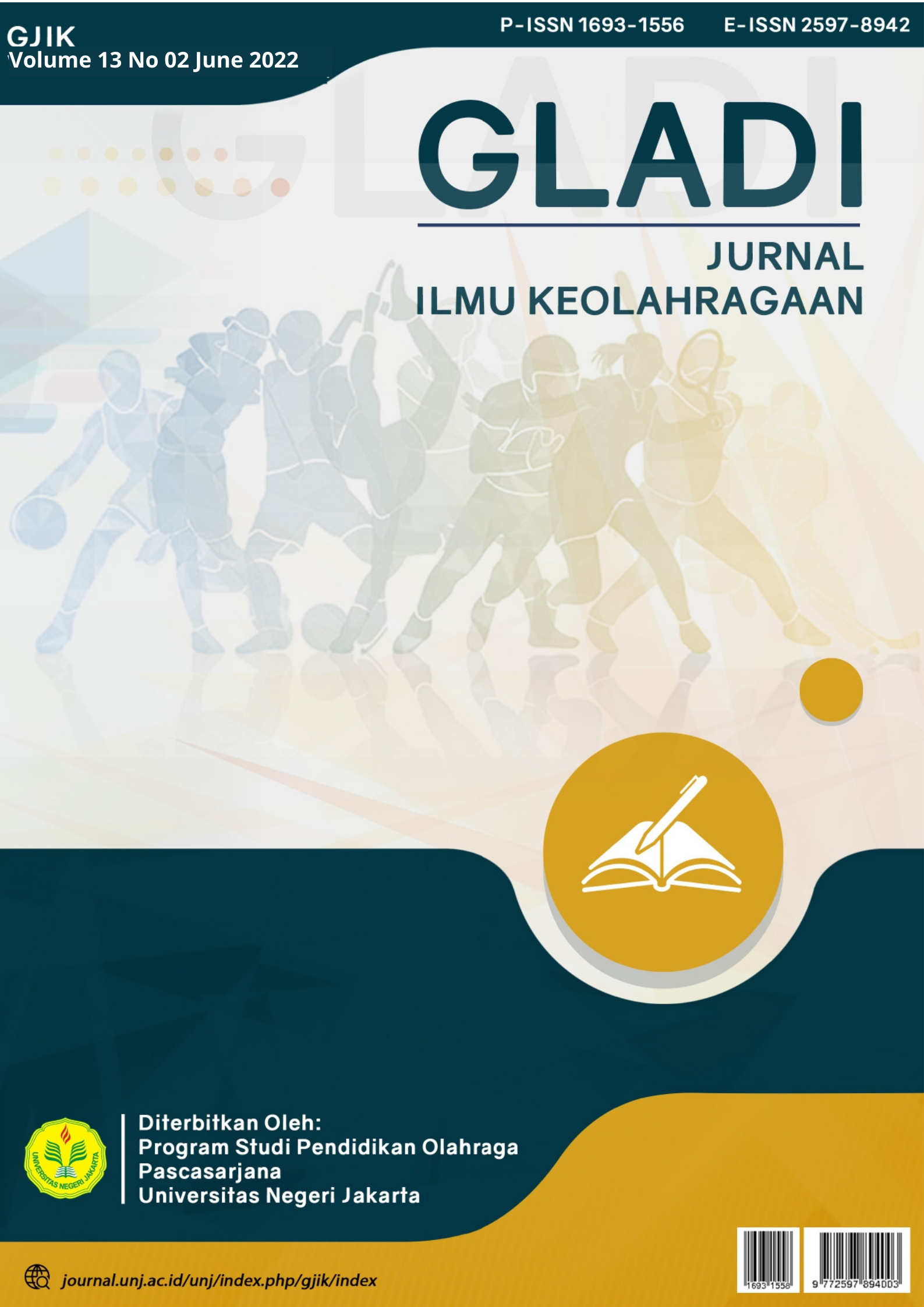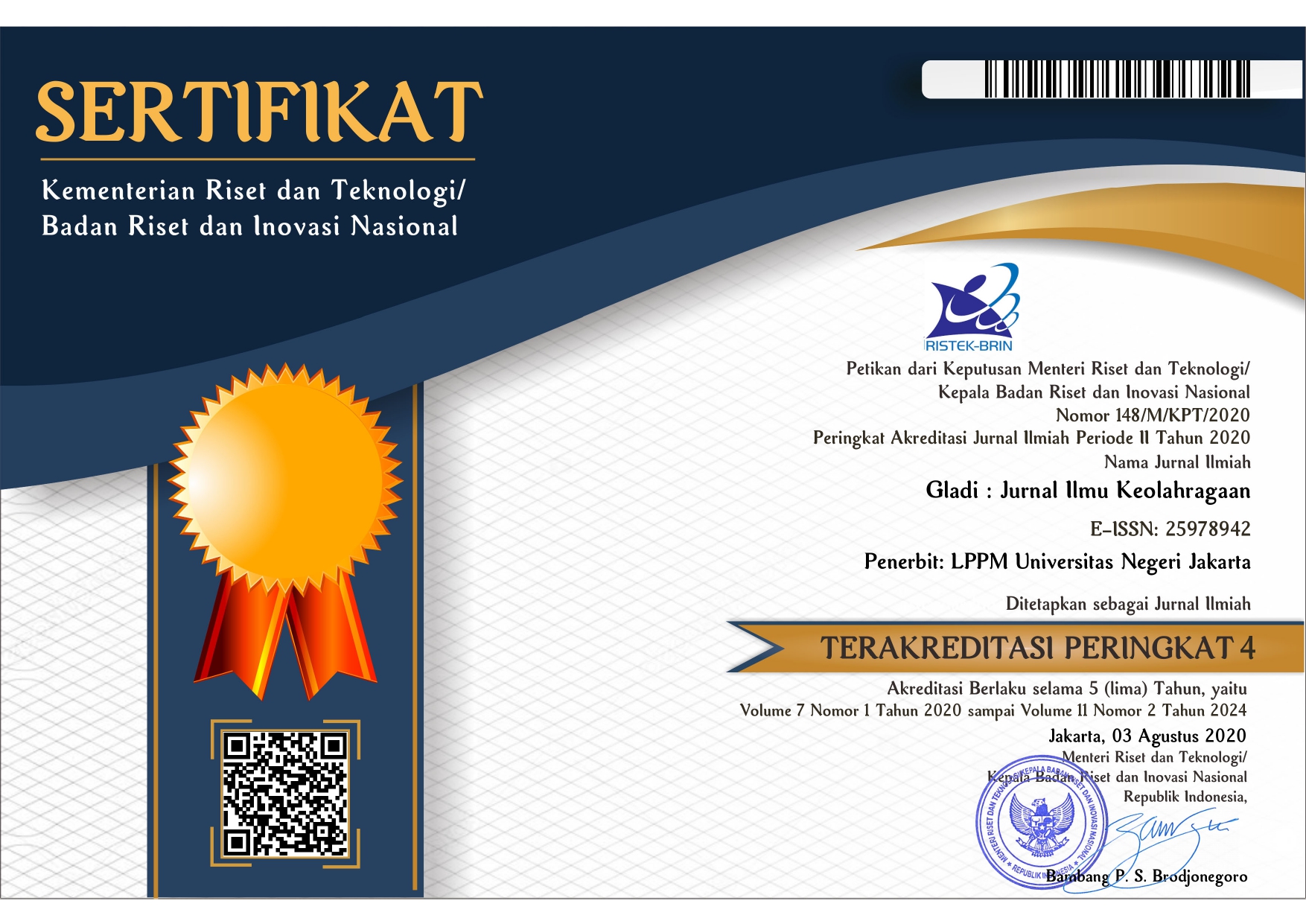The effect of quality of implementation of pjj pjokc conditions, and achievement motivation on the students' learning outcomes of sma negeri 25 jakarta (during the covid-19 pandemic)
Keywords:
physical education, Economic, Covid-19Abstract
This study aims to determine the effect of independent variables on the dependent variable. Judging from the title of the thesis, there are three independent variables, namely the quality of PJJ PJOK, socio-economic conditions, achievement motivation. As the dependent variable is the learning outcomes of Physical Education students at SMA Negeri 25 JAKARTA. To determine the extent of the influence of the quality of PJJ PJOK, socio-economic conditions, achievement motivation on learning outcomes of PJOK students of SMA Negeri 25 Jakarta. This research was conducted at SMA Negeri 25 Jakarta, Central Jakarta. The research was conducted using descriptive research methods with a quantitative approach. Descriptive research method is a method used to solve problems that exist in the present. Investigations in this method using interview techniques, questionnaires, observation. It can also use test techniques, case studies, cooperative or operational studies. Descriptive method is designed to gather information about real conditions now (while taking place). The main objective in using this method is to create descriptive, systematic, factual and accurate description of the facts, properties and relationships of the phenomena being investigated.
Samples were taken as many as 85 people, namely students of SMA Negeri 25 Jakarta. The sampling technique used was the Slovin technique and the data collection method used a questionnaire. Data analysis used descriptive analysis and path analysis.
The results of this study indicate that; (1) There is no direct influence between the quality of PJJ PJOK on Achievement Motivation for students of SMA Negeri 25 Jakarta, this is evidenced by a significance value of more than
0.05 (0.873> 0.05); (2) There is a direct influence between the Socio-Economic Conditions on Achievement Motivation in SMA Negeri 25 Jakarta, this is evidenced by a significance value less than 0.05 (0.047 <0.05); (3) There is a direct influence between the quality of PJJ PJOK on learning outcomes for students at SMA Negeri 25 Jakarta, this is evidenced by a significance value less than 0.05 (0.004 <0.05); (4) There is no direct influence between socio-economic conditions on learning outcomes for students of SMA Negeri 25 Jakarta, this is evidenced by the significance value obtained greater than 0.05 (0.564> 0.05); (5) There is no direct influence between Achievement Motivation on Learning Outcomes in SMA Negeri 25 Jakarta, this is evidenced by the significance value obtained greater than 0.05, greater than 0.05 (0.393> 0.05); (6) There is no indirect effect of the Quality of PJJ PJOK through Achievement Motivation on Learning Outcomes in SMA Negeri 25 Jakarta, this is evidenced by the beta coefficient value which is smaller than the beta coefficient which directly affects the quality of PJJ PJOK on learning outcomes of dribbling by 0.310 ( -0.02
<0.310); (7) There is no indirect effect between Socioeconomic Conditions through Achievement Motivation on Learning Outcomes in SMA Negeri 25 Jakarta, this is evidenced by the beta coefficient value which is smaller than the beta coefficient value, the direct effect of Socioeconomic Conditions on Learning Outcomes of 0.062 (0.020 <0.062).
Keywords: quality of PJJ PJOK, socio-economic conditions, achievement motivation, learning outcomes
Downloads
References
Achmad Sugandi, d. (2000). Belajar dan Pembelajaran. Semarang: IKIP PRESS.
Adit, A. (2020, 07 16). Kompas.com. Diambil kembali dari 4 Strategi Memperlancar Pembelajaran PJOK saat Pandemi: https://edukasi.kompas.com/read/2020/07/16/073327471/4-strategi-memperlancar-pembelajaran-pjok-saat-pandemi?page=all
Ahmadi, Abu.1997.Ilmu Sosial Dasar. Jakarta: Rineka Cipta.
Antonius Aditya Hartanto dan Onno W. Purbo. (2002). E-Learning berbasis PHP dan MySql, Elex Media Komputindo, Jakarta
Arsyad, Ashar. 2011. Media Pembelajaran. Jakarta: Raja Grafindo
B. Uno, Hamzah. 2008. Teori Motivasi dan Pengukurannya, Jakarta : Bumi Aksara.
Basrowi dan Juariyah, S. 2010. Analisis Kondisi Sosial Ekonomi dan Tingkat Pendidikan Masyarakat Desa Srigading, Kecamatan Labuhan Maringgai, Kabupaten Lampung Timur. Jurnal Ekonomi & Pendidikian, Vol.7 No.1, Hal. 58-81.
Belawati, Tian dkk. 1999. Pendidikan Terbuka Dan Jarak Jauh. Jakarta: Universitas Terbuka.
Darin E. Hartley (2001), “Selling e-Learning”, American Society for Training and Development
Darsono, Max.2000.Belajar dan Pembelajaran. Semarang:IKIP Semarang Press
Dohmen, G, (1967) dalam D. Keegan, (1986), The Foundations of Distance Education. London: Croom Helm
Dr.Riduwan. (2014). Metode dan Teknik Menyusun Proposal Penelitian (Untuk Mahasiswa S-1, S-2, dan S-3). Yogyakarta: Alfabeta.
Hamalik, Oemar. (2001). Proses Belajar Mengajar. Jakarta : Bumi Aksara.
Harjanto.1997. Perencanaan Pengajaran. Cetakan Pertama. Jakarta: PT. Rineka Cipta
Heini, Rita. 1999. Pengaruh Kondisi Sosial Ekonomi Orangtua terhadap prestasi belajar siswa kelas 3 SMU N 1 Pekalongan. Pendidikan Ekonomi UNNES Semarang
Ibrahim, R dan Nana Syaodih. 2003. Perencanaan Pengajaran. Jakarta: Rineka Cipta.
Munir. 2009. Pembelajaran Jarak Jauh Berbasis Teknologi Informasi dan Komunikasi. Bandung: Alfabeta
Nazir.Mohammad,Ph.D.(2011). Metode Penelitian. Jakarta : Ghalia Indonesia
Noor, Juliansyah. 2014. Metodologi Penelitian. Jakarta: Kencana Prenada Media Group
Kemp, Jerold E. (1977). Instructional Design. Belmont, California: David S. Lake Publishers.
Pipe, R. F. (1992). Analysing Performance Problems (2nd edn). London: Kogan Page.
RI, U. (2003). Undang-Undang No.20 Tahun 2003 Tentang Sistem Pendidikan Nasional.
Riyanto, Y. (2009). Paradigma Baru Pembelajaran. Jakarta: Kencana.
Robert F. Mager and Peter Pipe. (1992). Analysing Performance Problems (2nd edn). London: Kogan Page.
Rusman, dkk (2011) Pembelajaran Berbasis Teknologi Informasi dan Komunikasi : Mengembangkan Profesionalisme Guru. Jakarta:Rajawali Pers. PT. Raja Grafindo Persada
Setiawan, A. R. ( 2020). Lembar Kegiatan Literasi Saintifik untuk Pembelajaran Jarak Jauh Topik Penyakit Coronavirus 2019 (COVID-19). EDUKATIF: JURNAL ILMU PENDIDIKAN, 28-37.
Slameto. (2003). Belajar dan Faktor-faktor yang mempengaruhinya. Jakarta: Rineka Cipta.
Soekanto, Soerjono.1983. Kamus Sosiologi. Jakarta: CV. Rajawali.
Sugiyono (2015). Metode Penelitian Kombinasi (Mix Methods). Bandung: Alfabeta.
Sumardi, Mulyanto. 1982. Kemiskinan Dan Kebutuhan Pokok. Jakarta: Rajawali
Tim Penyusun Kamus Perbankan Indonesia, Kamus Perbankan, (Jakarta : Institut Bankir Indonesia, 1980)
Warsita, Bambang. 2011. Pendidikan Jarak Jauh. Bandung. PT Remaja Rosdakarya.
Uno, Hamzah B. Teori Minat Dan Pengukurannya. Jakarta: Bumi Aksara, 2008.
Uno, Hamzah B. Teori Minat Dan Pengukurannya. Jakarta: Bumi Aksara, 2012.
Verducci, Frank M. Measurement Concepts In Physical Education. St. Louis Missouri: Mosby Company, 1980.
Widiastuti. Tes Dan Pengukuran Olahraga. Jakarta: PT. Bumi Timur Jaya, 2014.







